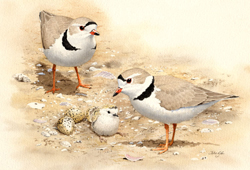Breeding Bird Atlases (BBA)
Find a Bird - BBA1
Breeding Bird Atlas 1 Species Accounts
Piping Plover
Charadrius melodus
State Status
Threatened
Federal Status
Threatened
Egg Dates
mid-April to mid-August
Number of Broods
one; may re-lay if first attempt fails.

During the Atlas period, nesting Piping Plovers were confirmed in 54 blocks, with the population distributed mainly about Cape Cod and the Islands north to Scituate. Piping Plovers were less frequent about the rocky shores of Buzzards Bay and were almost entirely absent from Massachusetts Bay. A few pairs nested north of Cape Ann. They were unrecorded inland. In January 1986, the Atlantic coastal population was listed as threatened by the United States Fish and Wildlife Service because of the decline of the species in many portions of its range since 1965. Massachusetts had an estimated population of 132 pairs at 43 stations in 1985 and 139 pairs at 49 stations in 1986 (MDFW). Aggressive management, including use of symbolic fencing on nesting grounds, restriction of off-road vehicles where unfledged plover chicks are present on the beaches, and use of specially designed predator exclosures for nests, has resulted in a dramatic increase to about 350 nesting pairs in 1994 (MDFW).
Piping Plovers first appear on Massachusetts beaches in late March, with the bulk of the population arriving in April. The birds occupy wide, barren, sandy beaches, usually preferring areas with scattered grass clumps, and they also use tidal flats for feeding. These plovers are inconspicuous, solitary nesters, often, but not necessarily, found in association with Least Terns, whose spirited group defense undoubtedly confers added protection from predators. The birds themselves have near-perfect protective coloration so that when they are immobile or crouching, they seem to disappear. Except to a trained observer, they would be undetectable were it not for their soft peep-lo that gives away their presence.
Courtship is a highly ritualized and protracted affair, with a month or more often passing before the first eggs are laid. Courting males are quite vocal and run around the female, crouching with wings and tail spread and drooping. Piping Plovers are typically monogamous within a nesting season but usually change mates from year to year.
The nest is a mere hollow in the sand, sometimes lined with pebbles or small bits of shell. Several practice scrapes are often fashioned by the male. Nests are normally on very sparsely vegetated beaches, often in the vicinity of blowouts or overwash fans, above the high tide line and usually within sight of water. They may be among small rocks, close to protective clumps of grass or beach detritus, or completely in the open.
Clutches of four eggs are almost invariably produced, with three sometimes appearing in second or subsequent nests. The earliest clutches are usually laid in late April. The eggs and chicks are extremely cryptic. Both sexes share incubation duties for about 27 days. If a nest gets destroyed by a predator or storm, pairs will renest repeatedly—up to five times—sometimes well into July. Usually, a different scrape in the same area is used for each subsequent nest.
Upon hatching, young depart the nest in a matter of hours and begin running far and wide over the beach. Chicks feed themselves but are closely brooded and guarded by the parents. Upon detection of an intruder, an adult will call (attracting its mate and sometimes other adults) and run conspicuously, feigning injury until the enemy has been lured a safe distance away. It then flies off and circles back, returning inconspicuously to the nest or young.
Adults with chicks are observed from late May through August. Young fledge 30 to 35 days after hatching, with the family unit continuing in a loose association for an undetermined period of time. Research on outer Cape Cod in 1985 to 1987 showed that breeding success was extremely low due to predation by Red Foxes, Striped Skunks, crows, and gulls, as well as due to human disturbance resulting in mean productivity of less than one chick fledged per pair (MacIvor 1990). Use of special predator exclosures for nests starting in 1988, symbolic fencing of nesting grounds, and exclusion of off-road vehicles from sections of beach where unfledged chicks are present boosted productivity to two chicks fledged per pair in the state in 1992 (MDFW).
Piping Plovers feed robinlike, making short runs, stopping and peering at the sand or mud surface in search of prey items. Their food includes insects, crustaceans, mollusks, sandworms, and other small marine animals. Most local Piping Plovers are gone by late August, though a few may remain into September. Transients appear on Massachusetts beaches from late July through September. The winter range is primarily on the Atlantic and Gulf coasts from North Carolina south to Florida and west to eastern Texas and, less commonly, throughout the Bahamas and Greater Antilles (east to the Virgin Islands).
The Piping Plover is listed as federally threatened in Massachusetts.
Map Legend and Data Summary
Atlas 1 data collected from 1975-1979


Note: very uncommon on sandy beaches; slowly increasing
Erma J. Fisk and Bradford G. Blodget



